Analysis of Haloferax mediterranei Lrp Transcriptional Regulator
Abstract
1. Introduction
2. Materials and Methods
2.1. Bioinformatic Analysis
2.2. Strains, Plasmids and Culture Conditions
2.3. Homologous Overexpression of pTA1992.lrp in Hfx. mediterranei HM26
2.4. Protein Purification and Determination of Molecular Mass
2.5. Characterization of lrp Promoter Region Using bgaH as a Reporter Gene
2.6. Western Blot Analysis
3. Results and Discussion
3.1. Lrp/AsnC Transcriptional Factor in Haloarchaea
3.2. Phylogeny and Lrp/AsnC Proteins Domains in Hfx. mediterranei R4
3.3. Gene-Environment
3.4. Overexpression, Purification and Determination of the Molecular Mass of Hfx. mediterranei Lrp
3.5. Characterization of lrp Promoter Region Using β-Galactosidase as a Reporter Gene
3.6. Western Blot
4. Conclusions
Supplementary Materials
Author Contributions
Funding
Institutional Review Board Statement
Informed Consent Statement
Data Availability Statement
Acknowledgments
Conflicts of Interest
References
- Oren, A. Molecular ecology of extremely halophilic Archaea and Bacteria. FEMS Microbiol. Ecol. 2002, 39, 1–7. [Google Scholar] [CrossRef] [PubMed]
- Andrei, A.-S.; Banciu, H.L.; Oren, A. Living with salt: Metabolic and phylogenetic diversity of archaea inhabiting saline ecosystems. FEMS Microbiol. Lett. 2012, 330, 1–9. [Google Scholar] [CrossRef] [PubMed]
- Cabrera, M. Ángeles; Blamey, J.M. Biotechnological applications of archaeal enzymes from extreme environments. Biol. Res. 2018, 51, 37. [Google Scholar] [CrossRef]
- Bonete, M.-J.; Martínez-Espinosa, R.M.; Pire, C.; Zafrilla, B.; Richardson, D.J. Nitrogen metabolism in haloarchaea. Saline Syst. 2008, 4, 9–12. [Google Scholar] [CrossRef]
- Koike, H.; Ishijima, S.A.; Clowney, L.; Suzuki, M. The archaeal feast/famine regulatory protein: Potential roles of its assembly forms for regulating transcription. Proc. Natl. Acad. Sci. USA 2004, 101, 2840–2845. [Google Scholar] [CrossRef]
- Lemmens, L.; Maklad, H.R.; Bervoets, I.; Peeters, E. Transcription Regulators in Archaea: Homologies and Differences with Bacterial Regulators. J. Mol. Biol. 2019, 431, 4132–4146. [Google Scholar] [CrossRef]
- Pérez-Rueda, E.; Janga, S.C. Identification and Genomic Analysis of Transcription Factors in Archaeal Genomes Exemplifies Their Functional Architecture and Evolutionary Origin. Mol. Biol. Evol. 2010, 27, 1449–1459. [Google Scholar] [CrossRef]
- Brinkman, A.B.; Ettema, T.J.G.; de Vos, W.M.; van der Oost, J. The Lrp family of transcriptional regulators. Mol. Microbiol. 2003, 48, 287–294. [Google Scholar] [CrossRef]
- Peeters, E.; Charlier, D. The Lrp Family of Transcription Regulators in Archaea. Archaea 2010, 2010, 750457. [Google Scholar] [CrossRef]
- Tani, T.H.; Khodursky, A.; Blumenthal, R.M.; Brown, P.O.; Matthews, R.G. Adaptation to famine: A family of stationary-phase genes revealed by microarray analysis. Proc. Natl. Acad. Sci. USA 2002, 99, 13471–13476. [Google Scholar] [CrossRef]
- Charlier, D.; Roovers, M.; Thia-Toong, T.-L.; Durbecq, V.; Glansdorff, N. Cloning and identification of the Sulfolobus solfataricus lrp gene encoding an archaeal homologue of the eubacterial leucine-responsive global transcriptional regulator Lrp. Gene 1997, 201, 63–68. [Google Scholar] [CrossRef]
- Schwaiger, R.; Schwarz, C.; Furtwängler, K.; Tarasov, V.; Wende, A.; Oesterhelt, D. Transcriptional control by two leucine-responsive regulatory proteins in Halobacterium salinarum R. BMC Mol. Biol. 2010, 11, 40. [Google Scholar] [CrossRef]
- Vassart, A.; van Wolferen, M.; Orell, A.; Hong, Y.; Peeters, E.; Albers, S.; Charlier, D. Sa- L rp from Sulfolobus acidocaldarius is a versatile, glutamine-responsive, and architectural transcriptional regulator. MicrobiologyOpen 2012, 2, 75–93. [Google Scholar] [CrossRef]
- Ouhammouch, M.; Geiduschek, E. A thermostable platform for transcriptional regulation: The DNA-binding properties of two Lrp homologs from the hyperthermophilic archaeon Methanococcus jannaschii. EMBO J. 2001, 20, 146–156. [Google Scholar] [CrossRef]
- Leonard, P.M.; Smits, S.H.; Sedelnikova, S.E.; Brinkman, A.B.; de Vos, W.M.; van der Oost, J.; Rice, D.W.; Rafferty, J.B. Crystal structure of the Lrp-like transcriptional regulator from the archaeon Pyrococcus furiosus. EMBO J. 2001, 20, 990–997. [Google Scholar] [CrossRef] [PubMed]
- Martãnez-Espinosa, R.M.; Esclapez, J.; Bautista, V.; Bonete, M.J.; Martínez-Espinosa, R.M.; Bonete, M.J. An octameric prokaryotic glutamine synthetase from the haloarchaeon Haloferax mediterranei. FEMS Microbiol. Lett. 2006, 264, 110–116. [Google Scholar] [CrossRef]
- Rodríguez-Herrero, V.; Payá, G.; Bautista, V.; Vegara, A.; Cortés-Molina, M.; Camacho, M.; Esclapez, J.; Bonete, M.J. Essentiality of the glnA gene in Haloferax mediterranei: Gene conversion and transcriptional analysis. Extremophiles 2020, 24, 433–446. [Google Scholar] [CrossRef]
- Sievers, F.; Wilm, A.; Dineen, D.; Gibson, T.J.; Karplus, K.; Li, W.; Lopez, R.; McWilliam, H.; Remmert, M.; Söding, J.; et al. Fast, scalable generation of high-quality protein multiple sequence alignments using Clustal Omega. Mol. Syst. Biol. 2011, 7, 539. [Google Scholar] [CrossRef] [PubMed]
- Söding, J. Protein homology detection by HMM-HMM comparison. Bioinformation 2005, 21, 951–960. [Google Scholar] [CrossRef]
- Letunic, I.; Bork, P. Interactive Tree of Life (iTOL) v4: Recent updates and new developments. Nucleic Acids Res. 2019, 47, W256–W259. [Google Scholar] [CrossRef]
- Pedro-Roig, L.; Lange, C.; Bonete, M.J.; Soppa, J.; Maupin-Furlow, J. Nitrogen regulation of protein-protein interactions and transcript levels of GlnK PII regulator and AmtB ammonium transporter homologs in Archaea. MicrobiologyOpen 2013, 2, 826–840. [Google Scholar] [CrossRef]
- Rodriguez-Valera, F.; Juez, G.; Kushner, D. Halobacterium mediterranei spec, nov., a New Carbohydrate-Utilizing Extreme Halophile. Syst. Appl. Microbiol. 1983, 4, 369–381. [Google Scholar] [CrossRef]
- Haque, R.U.; Paradisi, F.; Allers, T. Haloferax volcanii for biotechnology applications: Challenges, current state and perspectives. Appl. Microbiol. Biotechnol. 2020, 104, 1371–1382. [Google Scholar] [CrossRef] [PubMed]
- Haque, R.U.; Paradisi, F.; Allers, T. Haloferax volcanii as immobilised whole cell biocatalyst: New applications for halophilic systems. Appl. Microbiol. Biotechnol. 2019, 103, 3807–3817. [Google Scholar] [CrossRef] [PubMed]
- Holmes, M.L.; Scopes, R.K.; Moritz, R.L.; Simpson, R.J.; Englert, C.; Pfeifer, F.; Dyall-Smith, M.L. Purification and analysis of an extremely halophilic β-galactosidase from Haloferax alicantei. Biochim. Biophys. Acta Protein Struct. Mol. Enzym. 1997, 1337, 276–286. [Google Scholar] [CrossRef]
- Serrano-Gomicia, J.A. Ciclo del glioxilato en el arquea halófilo Haloferax volcanii: Análisis bioquímico, filogenético y transcripcional. Ph.D. Thesis, University of Alicante, Alicante, Spain, 2000. [Google Scholar]
- Dower, W.J.; Miller, J.F.; Ragsdale, C.W. High efficiency transformation of E. coli by high voltage electroporation. Nucleic Acids Res. 1988, 16, 6127–6145. [Google Scholar] [CrossRef]
- Cline, S.W.; Lam, W.L.; Charlebois, R.L.; Schalkwyk, L.C.; Doolittle, W.F. Transformation methods for halophilic archaebacteria. Can. J. Microbiol. 1989, 35, 148–152. [Google Scholar] [CrossRef]
- Bradford, M.M. A rapid and sensitive method for the quantitation of microgram quantities of protein utilizing the principle of protein-dye binding. Anal. Biochem. 1976, 72, 248–254. [Google Scholar] [CrossRef]
- Matarredona, L.; Camacho, M.; Zafrilla, B.; Bravo-Barrales, G.; Esclapez, J.; Bonete, M.-J. The Survival of Haloferax mediterranei under Stressful Conditions. Microorganisms 2021, 9, 336. [Google Scholar] [CrossRef]
- Oren, A.; Hallsworth, J.E. Microbial weeds in hypersaline habitats: The enigma of the weed-like Haloferax mediterranei. FEMS Microbiol. Lett. 2014, 359, 134–142. [Google Scholar] [CrossRef]
- Harris, T.J.; Emtage, J.S. Expression of heterologous genes in E. coli. Microbiol. Sci. 1986, 3, 28–31. [Google Scholar]
- Jia, B.; Jeon, C.O. High-throughput recombinant protein expression in Escherichia coli: Current status and future perspectives. Open Biol. 2016, 6, 160196. [Google Scholar] [CrossRef] [PubMed]
- Gileadi, O. Recombinant Protein Expression in E. coli: A Historical Perspective. In Methods in Molecular Biology; Springer Science and Business Media LLC: Berlin/Heidelberg, Germany, 2017; Volume 1586, pp. 3–10. [Google Scholar]
- Mevarech, M.; Frolow, F.; Gloss, L.M. Halophilic enzymes: Proteins with a grain of salt. Biophys. Chem. 2000, 86, 155–164. [Google Scholar] [CrossRef]
- Danson, M.J.; Hough, D.W. The Structural Basis of Protein Halophilicity. Comp. Biochem. Physiol. Part A Physiol. 1997, 117, 307–312. [Google Scholar] [CrossRef]
- Britton, K.L.; Baker, P.J.; Fisher, M.; Ruzheinikov, S.; Gilmour, D.J.; Bonete, M.-J.; Ferrer, J.; Pire, C.; Esclapez, J.; Rice, D.W. Analysis of protein solvent interactions in glucose dehydrogenase from the extreme halophile Haloferax mediterranei. Proc. Natl. Acad. Sci. USA 2006, 103, 4846–4851. [Google Scholar] [CrossRef] [PubMed]
- Domenech, J.; Ferrer, J. A new d-2-hydroxyacid dehydrogenase with dual coenzyme-specificity from Haloferax mediterranei, sequence analysis and heterologous overexpression. Biochim. Biophys. Acta Gen. Subj. 2006, 1760, 1667–1674. [Google Scholar] [CrossRef] [PubMed]
- Pire, C.; Esclapez, J.; Ferrer, J.; Bonete, M.-J. Heterologous overexpression of glucose dehydrogenase from the halophilic archaeonHaloferax mediterranei, an enzyme of the medium chain dehydrogenase/reductase family. FEMS Microbiol. Lett. 2001, 200, 221–227. [Google Scholar] [CrossRef] [PubMed]
- Diaz, S.; Pérez-Pomares, F.; Pire, C.; Ferrer, J.; Bonete, M.-J. Gene cloning, heterologous overexpression and optimized refolding of the NAD-glutamate dehydrogenase from Haloferax mediterranei. Extremophiles 2005, 10, 105–115. [Google Scholar] [CrossRef] [PubMed]
- Pérez-Pomares, F.; Bautista, V.; Ferrer, J.; Pire, C.; Marhuenda-Egea, F.C.; Bonete, M.-J.; Marhuenda-Egea, F. α-Amylase activity from the halophilic archaeon Haloferax mediterranei. Extremophiles 2003, 7, 299–306. [Google Scholar] [CrossRef]
- Camacho, M.; Rodríguez-Arnedo, A.; Bonete, M.-J. NADP-dependent isocitrate dehydrogenase from the halophilic archaeonHaloferax volcanii: Cloning, sequence determination and overexpression in Escherichia coli. FEMS Microbiol. Lett. 2002, 209, 155–160. [Google Scholar] [CrossRef]
- Esclapez, J.; Bonete, M.J.; Camacho, M.; Pire, C.; Ferrer, J.; Bautista, V.; Martínez-Espinosa, R.M.; Zafrilla, B.; Pérez-Pomares, F.; Díaz, S. An optimized method to produce halophilic proteins in Escherichia coli. Microb. Cell Fact. 2006, 5, S22. [Google Scholar] [CrossRef]
- Jolley, K.A.; Rapaport, E.; Hough, D.W.; Danson, M.J.; Woods, W.G.; Dyall-Smith, M.L. Dihydrolipoamide dehydrogenase from the halophilic archaeon Haloferax volcanii: Homologous overexpression of the cloned gene. J. Bacteriol. 1996, 178, 3044–3048. [Google Scholar] [CrossRef][Green Version]
- Fine, A.; Irihimovitch, V.; Dahan, I.; Konrad, Z.; Eichler, J. Cloning, Expression, and Purification of Functional Sec11a and Sec11b, Type I Signal Peptidases of the Archaeon Haloferax volcanii. J. Bacteriol. 2006, 188, 1911–1919. [Google Scholar] [CrossRef] [PubMed][Green Version]
- Timpson, L.M.; Liliensiek, A.-K.; Alsafadi, D.; Cassidy, J.; Sharkey, M.A.; Liddell, S.; Allers, T.; Paradisi, F. A comparison of two novel alcohol dehydrogenase enzymes (ADH1 and ADH2) from the extreme halophile Haloferax volcanii. Appl. Microbiol. Biotechnol. 2013, 97, 195–203. [Google Scholar] [CrossRef]
- Esclapez, J.; Zafrilla, B.; Martínez-Espinosa, R.M.; Bonete, M.-J. Cu-NirK from Haloferax mediterranei as an example of metalloprotein maturation and exportation via Tat system. Biochim. Biophys. Acta Proteins Proteom. 2013, 1834, 1003–1009. [Google Scholar] [CrossRef]
- Allers, T.; Barak, S.; Liddell, S.; Wardell, K.; Mevarech, M. Improved Strains and Plasmid Vectors for Conditional Overexpression of His-Tagged Proteins in Haloferax volcanii. Appl. Environ. Microbiol. 2010, 76, 1759–1769. [Google Scholar] [CrossRef]
- Bonete, M.-J.; Pire, C.; Llorca, F.I.; Camacho, M.L. Glucose dehydrogenase from the halophilic Archaeon Haloferax mediterranei: Enzyme purification, characterisation and N-terminal sequence. FEBS Lett. 1996, 383, 227–229. [Google Scholar] [CrossRef]
- Reddy, M.C.; Gokulan, K.; Jacobs, W., Jr.; Ioerger, T.R.; Sacchettini, J.C. Crystal structure of Mycobacterium tuberculosis LrpA, a leucine-responsive global regulator associated with starvation response. Protein Sci. 2007, 17, 159–170. [Google Scholar] [CrossRef]
- Thaw, P. Structural insight into gene transcriptional regulation and effector binding by the Lrp/AsnC family. Nucleic Acids Res. 2006, 34, 1439–1449. [Google Scholar] [CrossRef]
- Brinkman, A.B.; Dahlke, I.; Tuininga, J.E.; Lammers, T.; Dumay, V.; de Heus, E.; Lebbink, J.H.; Thomm, M.; de Vos, W.M.; van der Oost, J. An Lrp-like Transcriptional Regulator from the Archaeon Pyrococcus furiosus Is Negatively Autoregulated. J. Biol. Chem. 2000, 275, 38160–38169. [Google Scholar] [CrossRef]
- Brenneis, M.; Hering, O.; Lange, C.; Soppa, J. Experimental Characterization of Cis-Acting Elements Important for Translation and Transcription in Halophilic archaea. PLoS Genet. 2007, 3, e229. [Google Scholar] [CrossRef] [PubMed]
- Karr, E.A. The Methanogen-Specific Transcription Factor MsvR Regulates the fpaA-rlp-rub Oxidative Stress Operon Adjacent to msvR in Methanothermobacter thermautotrophicus. J. Bacteriol. 2010, 192, 5914–5922. [Google Scholar] [CrossRef] [PubMed]
- Plaisier, C.L.; Lo, F.-Y.; Ashworth, J.; Brooks, A.N.; Beer, K.D.; Kaur, A.; Pan, M.; Reiss, D.J.; Facciotti, M.T.; Baliga, N.S. Evolution of context dependent regulation by expansion of feast/famine regulatory proteins. BMC Syst. Biol. 2014, 8, 122. [Google Scholar] [CrossRef] [PubMed][Green Version]
- Aguilar-Barajas, E.; Jacobo-Arreola, S.; Verduzco-Rosas, L.A.; Jiménez-Mejía, R.; Ramírez-Díaz, M.I.; Julián-Sánchez, A.; Riveros-Rosas, H.; Cervantes, C. An Lrp-type transcriptional regulator controls expression of the Bacillus subtilis chromate transporter. Antonie Leeuwenhoek Int. J. Gen. Mol. Microbiol. 2013, 104, 941–948. [Google Scholar] [CrossRef]
- Pastor-Soler, S.; Camacho, M.; Bautista, V.; Bonete, M.-J.; Esclapez, J. Towards the Elucidation of Assimilative nasABC Operon Transcriptional Regulation in Haloferax mediterranei. Genes 2021, 12, 619. [Google Scholar] [CrossRef] [PubMed]
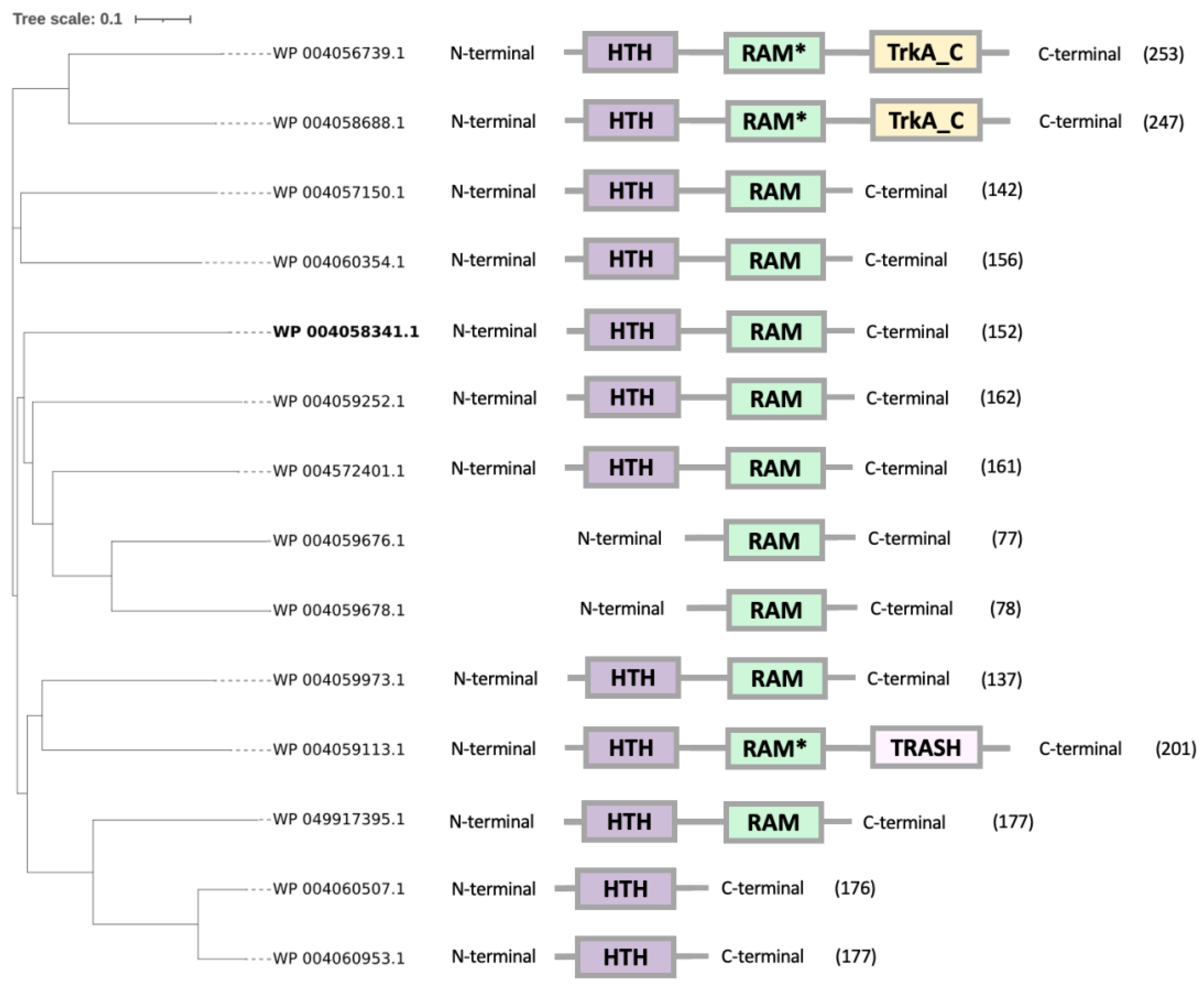

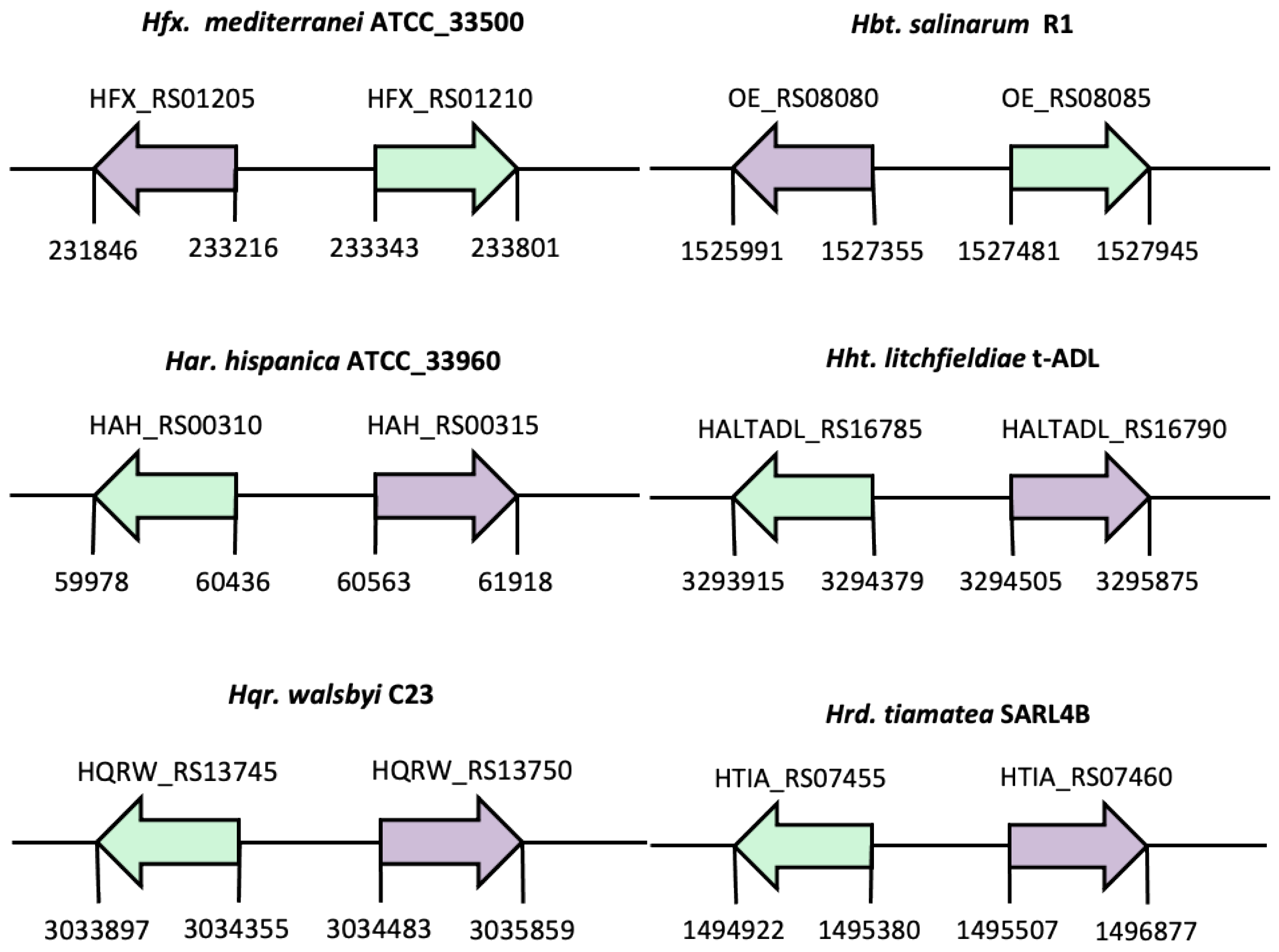
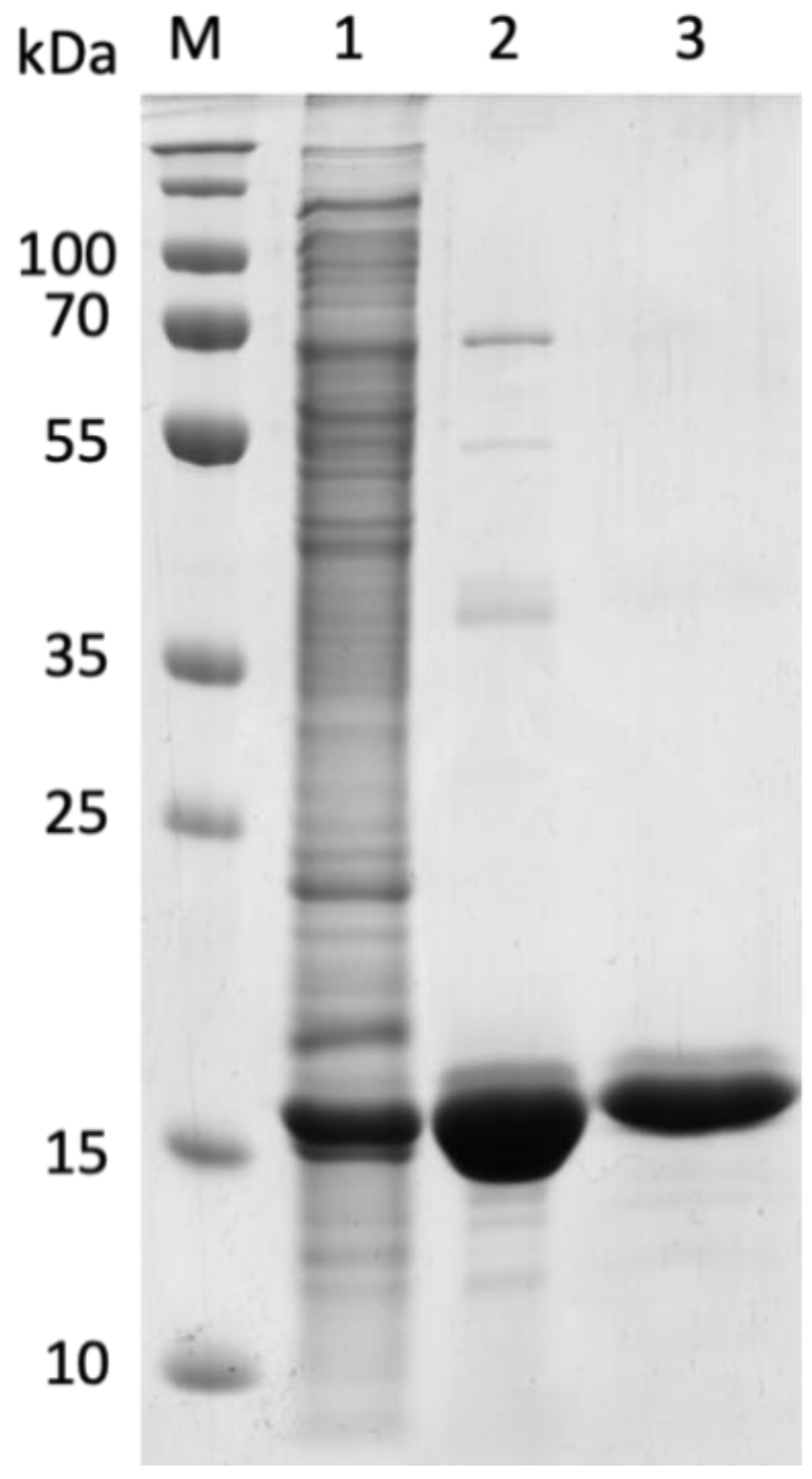

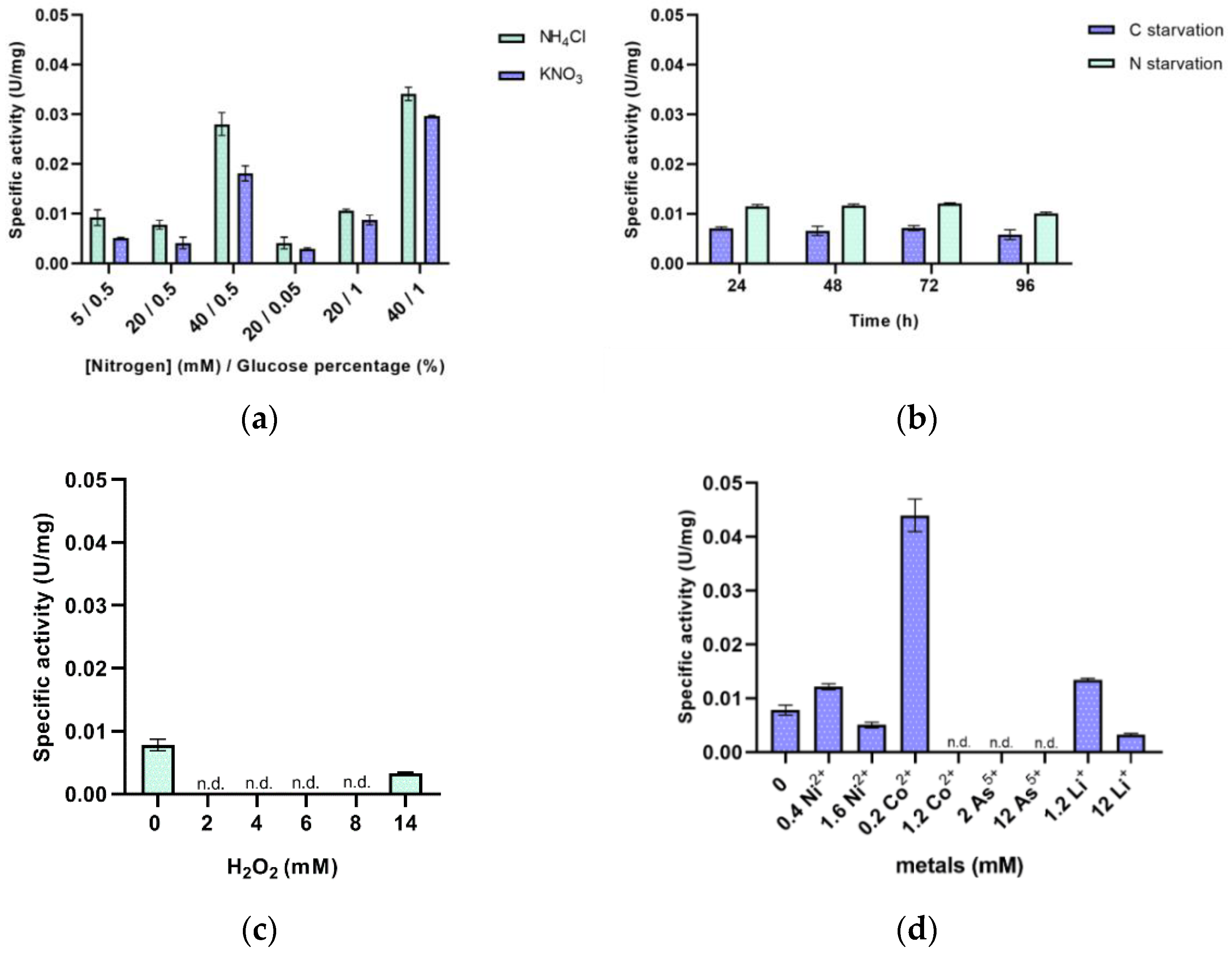
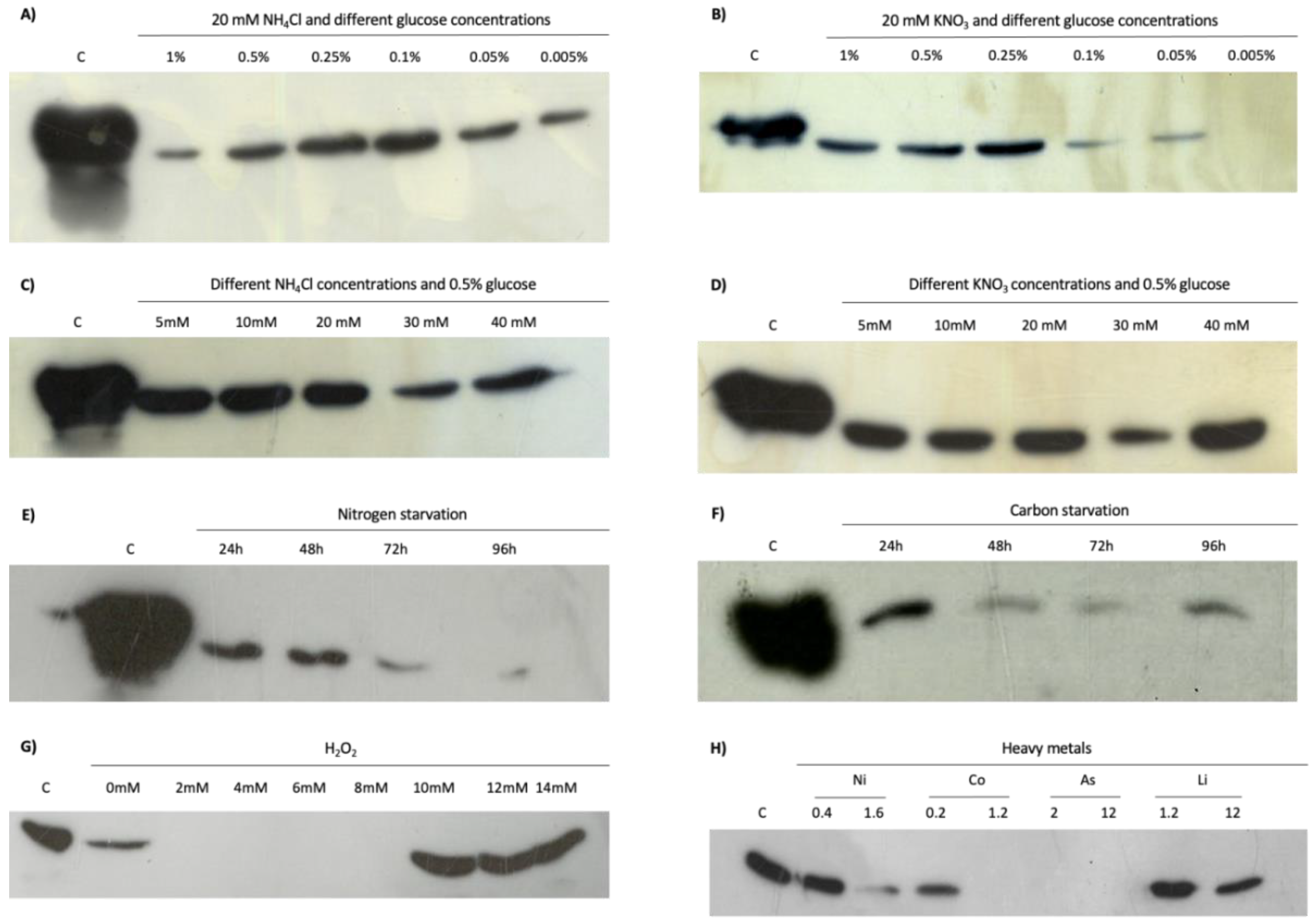
| Description | Culture Media |
|---|---|
| Complex medium | Hm-CM |
| Nitrogen and carbon conditions | |
| Different nitrogen source and concentrations | Hm-DM in the presence of 5–40 mM (5, 20 and 40 mM) ammonium or nitrate as the nitrogen source and 0.5% (w/v) glucose as the carbon source. |
| Different carbon source and concentrations | Hm-DM in the presence of 20 mM ammonium or nitrate as the nitrogen source and 0.05–1% (w/v) (0.05, 0.5 and 1%) glucose as the carbon source. |
| Starvation of nitrogen | Hm-NS |
| Starvation of carbon | Hm-CS |
| Stress conditions * | |
| Oxidative stress | Hm-DM cultures were grown to OD600 of 0.8 (mid-exponential phase) before adding H2O2 ranging from 2 to 14 mM (2, 4, 6, 8, 10, 12 and 14 mM). |
| Metal stress | Hm-DM cultures containing 0.4 and 1.6 mM nickel (Ni2+); 2 and 12 mM arsenic (As5+); 0.2 and 1.2 mM cobalt (Co2+); and 1.2 and 12 mM lithium (Li+). |
| Domain | ||||||
|---|---|---|---|---|---|---|
| Families * | Number of Lrp | HTH + Ligand-Binding | HTH | Ligand - Binding | HTH + TRASH | HTH + TrkA_C |
| Haloarculaceae | 426 | 63.7% | 15% | 19.7% | 1.4% | 0.2% |
| Halobacteriaceae | 344 | 62.8% | 10.8% | 19.8% | 3.5% | 3.1% |
| Halococcaceae | 48 | 91.9% | 5.4% | 2.7% | - | - |
| Haloferacaceae | 818 | 62.9% | 15.7% | 17.2% | 1.9% | 2.3% |
| Halorubraceae | 594 | 88.3% | 4.5% | 4.8% | 0.7% | 0.7% |
| Natrialbaceae | 731 | 60.2% | 16.2% | 21.4% | 1.4% | 0.2% |
| Volume (mL) | Protein (mg/mL) | Yield (%) | |
|---|---|---|---|
| Overexpressed extract | 25 | 13.89 | 100 |
| His-tagged fraction | 5 | 9.787 | 14.1 |
| Superose6 Increase 10/300 GL | 5 | 1.659 | 2.4 |
Publisher’s Note: MDPI stays neutral with regard to jurisdictional claims in published maps and institutional affiliations. |
© 2021 by the authors. Licensee MDPI, Basel, Switzerland. This article is an open access article distributed under the terms and conditions of the Creative Commons Attribution (CC BY) license (https://creativecommons.org/licenses/by/4.0/).
Share and Cite
Matarredona, L.; Camacho, M.; García-Bonete, M.-J.; Esquerra, B.; Zafrilla, B.; Esclapez, J.; Bonete, M.-J. Analysis of Haloferax mediterranei Lrp Transcriptional Regulator. Genes 2021, 12, 802. https://doi.org/10.3390/genes12060802
Matarredona L, Camacho M, García-Bonete M-J, Esquerra B, Zafrilla B, Esclapez J, Bonete M-J. Analysis of Haloferax mediterranei Lrp Transcriptional Regulator. Genes. 2021; 12(6):802. https://doi.org/10.3390/genes12060802
Chicago/Turabian StyleMatarredona, Laura, Mónica Camacho, María-José García-Bonete, Belén Esquerra, Basilio Zafrilla, Julia Esclapez, and María-José Bonete. 2021. "Analysis of Haloferax mediterranei Lrp Transcriptional Regulator" Genes 12, no. 6: 802. https://doi.org/10.3390/genes12060802
APA StyleMatarredona, L., Camacho, M., García-Bonete, M.-J., Esquerra, B., Zafrilla, B., Esclapez, J., & Bonete, M.-J. (2021). Analysis of Haloferax mediterranei Lrp Transcriptional Regulator. Genes, 12(6), 802. https://doi.org/10.3390/genes12060802









